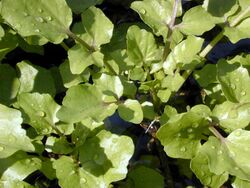Biology:Nasturtium (genus)
| Nasturtium | |
|---|---|

| |
| Nasturtium microphyllum, a watercress, in Hawai'i | |
| Scientific classification | |
| Kingdom: | Plantae |
| Clade: | Tracheophytes |
| Clade: | Angiosperms |
| Clade: | Eudicots |
| Clade: | Rosids |
| Order: | Brassicales |
| Family: | Brassicaceae |
| Genus: | Nasturtium W.T. Aiton |
| Species | |
| |
Nasturtium (/nəˈstɜːrʃəm/) is a genus of seven plant species in the family Brassicaceae (cabbage family), best known for the edible watercresses Nasturtium microphyllum (Rorippa microphylla) and Nasturtium officinale (R. nasturtium-aquaticum). Nasturtium was previously synonymised with Rorippa, but molecular evidence supports its maintenance as a distinct genus more closely related to Cardamine than to Rorippa sensu stricto (Al-Shehbaz & Price, 1998; Al-Shehbaz, Beilstein & Kellogg, 2006). Watercress or yellowcress is a common name for plants in this genus.[1]
These plants are related to garden cress and mustard, noteworthy for a peppery, tangy (pungent) flavor. The name Nasturtium comes from the Latin nasus tortus, meaning "twisted nose", in reference to the effect on the nasal passages of eating the plants. Nasturtium foliage is used as food by the caterpillars of certain Lepidoptera, including Orthonama obstipata (The Gem).
One species, Nasturtium gambellii, is a federally listed in California as an endangered species in the United States.[2]
Nomenclature
The genus Nasturtium should not be confused with the ornamental garden plant, usually grown as an annual, that is commonly known as nasturtium (Tropaeolum majus). Though not closely related, the leaves of the garden nasturtium also have a peppery taste.
Species list
One database names 316 species. [3]
- Nasturtium africanum, Moroccan watercress or Moroccan yellowcress
- Nasturtium floridanum, Florida watercress or Florida yellowcress
- Nasturtium gambellii, Gambel's watercress or Gambel's yellowcress
- Nasturtium groenlandicum, (Hornem.) Kuntze
- Nasturtium microphyllum, onerow watercress or onerow yellowcress
- Nasturtium officinale, watercress or yellowcress
- Nasturtium sordidum, (A. Gray) Kuntze
References
- ↑ "Nasturtium". Natural Resources Conservation Service PLANTS Database. USDA. https://plants.usda.gov/core/profile?symbol=NASTU2. Retrieved 18 July 2015.
- ↑ "Rorippa gambellii [Nasturtium gambelii (Gambel's watercress) 5-Year Review: Summary and Evaluation"]. September 2011. https://www.fws.gov/carlsbad/SpeciesStatusList/5YR/20111107_5YR_NAGA.pdf.
- ↑ Plant Systematics: Nasturtium
Sources
- Al-Shehbaz, I. A. and R. A. Price, 1998. Delimitation of the genus Nasturtium (Brassicaceae). Novon 8: 124-126.
- Al-Shehbaz, I. A., M. A. Beilstein, and E. A. Kellogg, 2006. Systematics and phylogeny of the Brassicaceae (Cruciferae): an overview. Plant Systematics and Evolution 259: 89–120
Wikidata ☰ Q161068 entry

